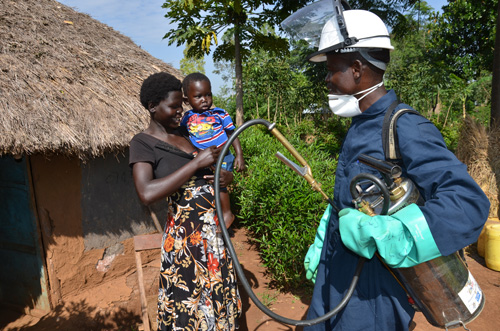 Malaria is the leading cause of morbidity and mortality in Uganda. Accounting for 30 – 50 percent of outpatient visits and 15 – 20 percent of hospital admissions, malaria places a huge burden on the Ugandan health system. Recent PMI-supported activities include IRS in high burden eastern and east-central districts with persistently high malaria prevalence rates; ITN distribution via ANC/EPI clinics and school outlets as well as social marketing of nets at a subsidized price; training and supervision of health workers in integrated management of malaria including malaria in pregnancy; a collection of surveillance data; management and monitoring of insecticide resistance; and behavior change communication activities that reach millions of Ugandans with key malaria messages.
Malaria is the leading cause of morbidity and mortality in Uganda. Accounting for 30 – 50 percent of outpatient visits and 15 – 20 percent of hospital admissions, malaria places a huge burden on the Ugandan health system. Recent PMI-supported activities include IRS in high burden eastern and east-central districts with persistently high malaria prevalence rates; ITN distribution via ANC/EPI clinics and school outlets as well as social marketing of nets at a subsidized price; training and supervision of health workers in integrated management of malaria including malaria in pregnancy; a collection of surveillance data; management and monitoring of insecticide resistance; and behavior change communication activities that reach millions of Ugandans with key malaria messages.
In 2019, the PMI VectorLink Uganda project, conducted IRS in 15 districts, targeting 1,369,305 structures from March 18-June 26, 2019. A total of 1,291,569 structures were sprayed out of 1,393,562 structures found by spray operators in the targeted districts, resulting in a spray coverage rate of 92.7 percent.
In 2020, VectorLink Uganda conducted IRS in 16 districts, targeting 1,393,562 structures, starting with the remaining balance of 2019 Actellic 300CS in seven Phase I districts and SumiShield 50WG in eight Phase II districts, followed by Fludora Fusion in all the 16 Phase I and II districts from March 2 through June 23, 2020. The project sprayed a total of 1,395,569 structures out of 1,475,422 structures found by spray operators in the targeted districts during the 2020 IRS campaign, resulting in a 94.6% spray coverage rate.
In 2021, VectorLink Uganda conducted IRS in 14 districts (four of them the final FCDO districts), targeting 1,321,459 structures from March 1 through May 22, 2021. The project sprayed a total of 1,294,515 structures out of 1,387,270 structures found by spray operators in the targeted districts during the 2021 IRS campaign, resulting in a 93.3% spray coverage rate.
In year five (January 2022 – December 2022), VectorLink Uganda continued working with the MOH’s National Malaria Control Division (NMCD), districts, and sub-county stakeholders to target 1,125,143 eligible structures in 10 PMI-funded districts using Fludora Fusion in eight districts (Budaka, Butaleja, Butebo, Kibuku, Lira, Namutumba, Pallisa and Serere) and SumiShield in two districts (Bugiri and Tororo). The project paid keen attention to the lessons learned during the spray campaign in 2021 and built on that for the 2022 spray campaign. The project worked closely with the MOH and the district health management teams to ensure that all COVID-19 guidelines are observed in the course of project implementation to mitigate any transmission.
The project’s primary objective is to reach a minimum coverage of 85% of the structures found in each district by implementing high-quality IRS operations, but the project will aim to reach the highest coverage level possible. In addition to spraying, in Year 5, the project will carry out the following activities:
- Strengthen capacity at the national, regional, district, and local levels to manage IRS operations, including planning, spraying, resource allocation, and monitoring and evaluation (M&E).
- Support the six FCDO districts of Alebtong, Amolatar, Dokolo, Kaberamaido, Kalaki, and Otuke where IRS has been withdrawn and the 10 PMI-supported districts to strengthen routine entomological surveillance and monitor the implementation strategies to sustain the gains from IRS and other malaria interventions.
- Collaborate with PMI district leaders and other stakeholders on prioritizing implementation of activities in their IRS exit/sustainability plans and sourcing resources to implement those key priority activities.
- Conduct training with a focus on IRS supervision and spray techniques to improve the overall quality of spraying while observing COVID-19 protocols.
- Offer technical support to the MOH/NMCD in preparation for the Global Fund-supported IRS in the 12 West Nile districts which will be sprayed for the first time in 2022.
- Conduct regular M&E of project activities to ensure alignment with set targets and objectives and continue mobile data collection pilot in five operation sites in Bugiri district for a second year.
- Mainstream gender equality and female empowerment by ensuring women’s participation in all project activities.
- Involve youth in spray activities in the target districts by engaging them as parish mobilizers and sensitize youth groups in churches and encourage them to sensitize the community in turn about IRS. The project will also recruit youth over 18 years of age as spray team members and encourage them to sensitize the community in their villages in partnership with the Local Council 1s (LC1s (village leaders)) during spraying.
- Carry out a logistics assessment in all districts, and arrange all procurement, shipping, delivery, and storage of IRS commodities.
- Use digital scanning devices and open-source software to track movement of serialized insecticide at selected operation sites.
- Coordinate community mobilization activities in collaboration with stakeholders to raise awareness of IRS and encourage beneficiary and stakeholder ownership.
- Conduct insecticide resistance, wall bioassay, and vector density monitoring; vector behavioral studies; and ITN durability monitoring.
- Ensure safe and correct insecticide application, thus minimizing human and environmental exposure to IRS insecticides, in compliance with the Pesticide Evaluation Report and Safer Use Action Plan and Supplemental Environmental Assessment.
Success stories from PMI VectorLink Uganda:

